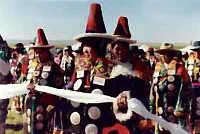|
Hada: Incarnation of Friendship and Fraternity
( 2005-10-27 )
On some rare occasions, five-colored hada are used to present to Buddha intemples and monasteries. The five colors -- blue, white, yellow, green, and red -- represent the sky, clouds, earth, river, and the god of protection respectively. The length of the hada also varies. The longest hada can be as long as three meters whereas the shortest can fit inside a small envelope.
 Origin of hada Origin of hada
 The hada is pronounced "kha-(b)tags" in Tibetan. Folklore historians believe that the tradition of the hada presentation can be traced back to the reign ofKublai Khan, the founder of China'sYuan Dynasty(1271-1368). Basipa (Phags-pa) returned to Tibet in 1264 after his special trip to pay tribute to Kublai Khan in Northwest China'sGansu Province. He brought back a hada with the design of theGreat WallandChinese charactersthat meant "as lucky as one wishes." When he went to worship the Buddha at the Jokhang Temple inLhasa, the Tibetan capital, Basipa presented the hada to the Buddha. Later, the hada was endowed with a religious connotation, referred to as "fairies' streamers." The hada is pronounced "kha-(b)tags" in Tibetan. Folklore historians believe that the tradition of the hada presentation can be traced back to the reign ofKublai Khan, the founder of China'sYuan Dynasty(1271-1368). Basipa (Phags-pa) returned to Tibet in 1264 after his special trip to pay tribute to Kublai Khan in Northwest China'sGansu Province. He brought back a hada with the design of theGreat WallandChinese charactersthat meant "as lucky as one wishes." When he went to worship the Buddha at the Jokhang Temple inLhasa, the Tibetan capital, Basipa presented the hada to the Buddha. Later, the hada was endowed with a religious connotation, referred to as "fairies' streamers."
 White: cleanliness and sincerity White: cleanliness and sincerity
History recalls that people of theHan Dynasty(206BC-220AD) often used strips of white cloth as gifts, while some researchers say that pronunciation of hada sounds much like a Tibetan modification of the Mongolian word hadaka. It is still arguable whether the Han people or the Mongolians invented the hada. In any case, Kublai Khan was the leader of the Mongolians.
Though both Mongolians and Tibetans cherish the tradition of presenting hada at various occasions, Mongolians prefer to use blue and yellow hada whereas Tibetans choose to use white ones. White represents cleanliness and sincerity in Tibet.
|

